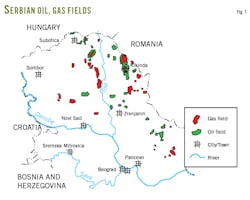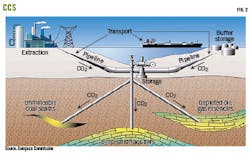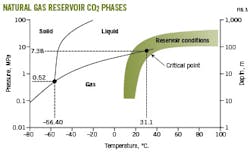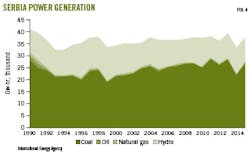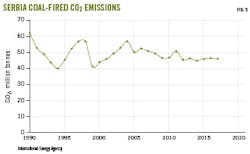Slavko Nesic
STC NIS Gazprom Neft
Novi Sad, Serbia
Vladimir Mitrovic
Marina Filipovic
University of Belgrade
Belgrade
Serbia is assessing its potential for long-term carbon dioxide storage using depleted or partially depleted oil and gas reservoirs in Pannonian basin to help mitigate climate change.
Laboratory tests show some oil fields likely could benefit from CO2 enhanced oil recovery (EOR) although more research and pilot tests are needed. Depleted or partially depleted natural gas fields having reservoirs at least 800 m deep offer promising CO2 storage options.
EOR is one form of carbon capture and storage (CCS). Most of northern Serbia's oil and gas fields are in Pannonian basin. Serbia's portion of the basin spans 26,000 sq km and hosts more than 300 reservoirs, including 80 discovered oil and gas fields.
Some 400 exploration wells and 1,400 appraisal wells have been drilled. Currently, 53 oil and gas fields are in production with about 1,000 wells total.1
Fig. 1 shows Serbia's oil and gas fields, most of which are in their final production phases with a high water cut. They are CO2 EOR candidates but the depleted oil reservoirs are shallow, making them less attractive candidates than the gas reservoirs.
Deep saline aquifers have uncertainties, including geothermal gradients and methane-rich water, that could curb their potential as CO2 storage candidates. More research is needed.
Rusanda oil field
Rusanda oil field is Serbia's first CO2 EOR project. NIS Co. invested more than €30 million ($34.8 million) in its High-Pressure Acid-gas Capture Technology (HiPACT) amine plant, which removes CO2 from natural gas. Gazprom Neft owns 56% interest in NIS and Serbia 30%, the remaining interest divided between other minor shareholders.
HiPACT, built in Elemir, removes CO2 for injection in the gas cap of Rusanda field to increase reservoir pressure and the recovery factor. The plant currently injects 120,000 cu m/d of CO2 compared with about 80,000 cu m/day when it started in 2013.2
Pannonian basin falls within Hungary, Croatia, Romania, and Serbia. It has a history of sedimentation, volcanism, tectonic activity, and geothermal reservoirs. Serbia hosts 113 geothermal wells in its portion of Pannonian basin. These geothermal wells, drilled during exploration, have been used very little because they are remote.
Serbia's portion of Pannonian basin features four basic hydrogeological systems:
• Pontian sediment rocks consisting of sands and gravel of various granulations with a clay cap rock. This system covers nearly all of Vojvodina province except Fruska Gora and Vrsacki Breg. Its water has mineralization of 3-5 mg/l.
• Lower Pontian and Pannonian sediment rocks, featuring sandstones and cap rocks that are marls, marlstones, and clays. Mineral content varies from 5-20 mg/l.
• Miocene, Paleogene, Jurassic, and Cretaceous rocks and cap rocks that are marls, marlstones, and clays. Formation waters have 50 mg/l. mineralization.
• Magmatic, metamorphic, and sedimentary rocks of Triassic and Paleozoic ages.
CCS implementation
For CO2 storage in saline aquifers, Serbia's best available options are 2,000 m deep where the geothermal gradient varies from 95-120° C. Saline aquifers are distributed widely worldwide but researchers know little about their geological properties relative to CCS.3-5
Serbia's coal seams are mostly shallow and not considered good CCS candidates.
Fig. 2 is a CCS schematic showing options, which include depleted oil and gas reservoirs, featuring seals and traps that have retained oil and gas for millions of years. Reservoir properties are well known from years of production.
CCS projects must follow strict standards. Possible migration of CO2 from storage formation to the surface poses a health risk. Safety concerns about CCS trigger negative public perception.
Key factors influencing geological storage of CO2 include formation depth, state of CO2 in geological condition, and the formation's fractures and faults.
Studies recommend CO2 should be stored deeper than 800 m in reservoirs with temperatures hotter than 310° C. and critical pressure around 7.5 MPa.
Cap rocks must have enough thickness to hold CO2 for thousands of years and minimal faulting. Fig. 3 shows CO2 phases within a gas reservoir.
Industry has emitted large quantities of greenhouse gases into the atmosphere, contributing to global warming. Fossil fuel combustion has increased the atmosphere's concentration of anthropogenic CO2.
CCS reduces CO2 emissions from the atmosphere. Europe hosts many CCS projects with the European Union providing financial support for some of them. Europe is striving to achieve zero-emission fossil fuel power plants.
Serbia has no CCS projects yet, but it must follow European Commission regulations for lowering CO2 emissions.
The authors sought to identify possible geological formations for successful implementation. They made no attempt to estimate storage capacity.
Serbia's electric generation creates about 45 million tonnes/year of CO2 from 24 point sources, mostly in central Serbia away from oil and gas fields. Fig. 4 shows electric generation by fuel type while Fig. 5 shows CO2 emissions from coal combustion. Serbia has 18 coal-fired power plants and 6 power plants fired by gas and liquid fuels.
Shallow reservoirs are unsuitable for CO2 storage, except for gas reservoirs because they have sealing caps. But increased reservoir depth means higher injection and completion costs.
Transportation is a major CCS issue. Serbia's coal-fired power plants are far from oil and gas fields, requiring new pipelines to move captured gas to storage or else using trucks to move it in liquid form.References
1. Mikhail, D., "New Activities in Exploration and Production," NIS Co. International Corporate magazine, Energize, September 2016.
2. Stanojevski, N., "Amine Scrubbing Enchanes Gas Quality," NIS Co. International Corporate magazine, Energize, March 2016.
3. Benson, S.M. "Overview of Geologic Storage of CO2," Carbon Dioxide Capture for Storage in Deep Geologic Formations study, US Department of Energy, December 2005, pp. 665-72.
4. Holloway, S. "An overview of the underground disposal of carbon dioxide." Energy Conversion and Management, Vol. 38 Supplement, 1997, pp. s193-s198.
5. Orr, F., "Storage of Carbon Dioxide in Geologic Formations," Society of Petroleum Engineers Journal of Petroleum Technology, Vol. 56, No. 9, September 2004, pp. 90-97.
The authors
Slavko Nesic ([email protected]) is a hydrodynamical modelling specialist in the Scientific Technology Center of NIS Gazprom Neft. He has BS (xxxx) and MS (xxxx) degrees in petroleum engineering from the University of Belgrade, Faculty of Mining and Geology, where he is completing his PhD studies. He attended several research internships at Gubkin University in Moscow and has experience in reservoir engineering, management, and modeling.
Vladimir Mitrovic ([email protected]) is a petroleum engineering professor at the University of Belgrade, Faculty of Mining and Geology. He has 40-years' experience in reservoir engineering research and teaching. He has BS, MS, and PhD (xxxx) degrees in petroleum engineering from the University of Belgrade.
Marina Filipovic ([email protected]) is a PhD student and teaching assistant at the University of Belgrade Faculty of Security Studies. She obtained a BS (2008) and MS degree (xxxx) from the University of Belgrade. She focuses on localized environmental security of a community, social ecology, and environmental protection.
